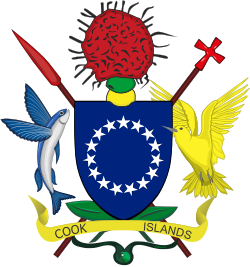| Coat of arms of the Cook Islands | |
|---|---|
 | |
| Versions | |
 Emblem of the Cook Islands Federation | |
| Armiger | Cook Islands |
| Supporters | Flying fish (maroro) and white tern (kakaia) |
The coat of arms of the Cook Islands has a shield as its focal point. The shield is blue with fifteen white stars arranged in a circle, as found on the national flag, and is supported by a flying fish (maroro) and a white tern (kakaia). The helmet is an ariki head-dress (pare kura) of red feathers, symbolising the importance of the traditional rank system, and the name of the nation is on a scroll below the shield. The achievement is augmented by a cross and a Rarotongan club (momore taringavaru) used by orators during traditional discourses, respectively symbolizing Christianity and the richness of Cook Islands' tradition, placed in saltire behind the shield. [1]
The coat of arms was designed by Mataiapo Metuakore Teremoana Ngametua Tutakiao Kora BEM , also known as Papa Motu Kora. [1] [2]